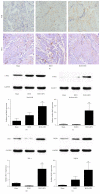Sulforaphane Ameliorates Bladder Dysfunction through Activation of the Nrf2-ARE Pathway in a Rat Model of Partial Bladder Outlet Obstruction
- PMID: 27433291
- PMCID: PMC4940551
- DOI: 10.1155/2016/7598294
Sulforaphane Ameliorates Bladder Dysfunction through Activation of the Nrf2-ARE Pathway in a Rat Model of Partial Bladder Outlet Obstruction
Abstract
Purpose. We evaluated the effect of sulforaphane (SFN) treatment on the function and changes of expression of Nrf2-ARE pathway in the bladder of rats with bladder outlet obstruction (BOO). Materials and Methods. A total of 18 male Sprague-Dawley rats at age of 8 weeks were divided into 3 groups (6 of each): the sham operated group, the BOO group, and the BOO+SFN group. We examined histological alterations and the changes of oxidative stress markers and the protein expression of the Nrf2-ARE pathway. Results. We found that SFN treatment could prolong micturition interval and increase bladder capacity and bladder compliance. However, the peak voiding pressure was lower than BOO group. SFN treatment can ameliorate the increase of collagen fibers induced by obstruction. SFN treatment also increased the activity of SOD, GSH-Px, and CAT compared to the other groups. The level of bladder cell apoptosis was decreased in BOO rats with SFN treatment. Moreover, SFN could reduce the ratio of Bax/Bcl-2 expression. Furthermore, SFN could activate the Nrf2 expression with elevation of its target antioxidant proteins. Conclusions. The sulforaphane-mediated decrease of oxidative stress and activation of the Nrf2-ARE pathway may ameliorate bladder dysfunction caused by bladder outlet obstruction.
Figures





Similar articles
-
Effect of Sulforaphane on Bladder Compliance in a Rat Model of Partial Bladder Outlet Obstruction.Oxid Med Cell Longev. 2019 Jun 18;2019:6026719. doi: 10.1155/2019/6026719. eCollection 2019. Oxid Med Cell Longev. 2019. PMID: 31316719 Free PMC article.
-
Sulforaphane Treatment of Stress Urinary Incontinence Via the Nrf2-ARE Pathway in a Rat Model.Cell Physiol Biochem. 2017;44(5):1912-1922. doi: 10.1159/000485880. Epub 2017 Dec 8. Cell Physiol Biochem. 2017. PMID: 29224018
-
Sulforaphane Protect Against Cadmium-Induced Oxidative Damage in mouse Leydigs Cells by Activating Nrf2/ARE Signaling Pathway.Int J Mol Sci. 2019 Feb 1;20(3):630. doi: 10.3390/ijms20030630. Int J Mol Sci. 2019. PMID: 30717178 Free PMC article.
-
Modulation of mitochondrial functions by the indirect antioxidant sulforaphane: a seemingly contradictory dual role and an integrative hypothesis.Free Radic Biol Med. 2013 Dec;65:1078-1089. doi: 10.1016/j.freeradbiomed.2013.08.182. Epub 2013 Aug 30. Free Radic Biol Med. 2013. PMID: 23999506 Review.
-
Anticancer Activity of Sulforaphane: The Epigenetic Mechanisms and the Nrf2 Signaling Pathway.Oxid Med Cell Longev. 2018 Jun 6;2018:5438179. doi: 10.1155/2018/5438179. eCollection 2018. Oxid Med Cell Longev. 2018. PMID: 29977456 Free PMC article. Review.
Cited by
-
A Review of Oxidative Stress and Urinary Dysfunction Caused by Bladder Outlet Obstruction and Treatments Using Antioxidants.Antioxidants (Basel). 2019 May 15;8(5):132. doi: 10.3390/antiox8050132. Antioxidants (Basel). 2019. PMID: 31096597 Free PMC article. Review.
-
Effect of Sulforaphane on Bladder Compliance in a Rat Model of Partial Bladder Outlet Obstruction.Oxid Med Cell Longev. 2019 Jun 18;2019:6026719. doi: 10.1155/2019/6026719. eCollection 2019. Oxid Med Cell Longev. 2019. PMID: 31316719 Free PMC article.
-
Spinal CRH facilitates the micturition reflex via the CRH2 receptor in rats with normal bladder and bladder outlet obstruction.Sci Rep. 2025 Jan 29;15(1):3604. doi: 10.1038/s41598-025-87990-w. Sci Rep. 2025. PMID: 39875474 Free PMC article.
-
The Glucosinolates: A Sulphur Glucoside Family of Mustard Anti-Tumour and Antimicrobial Phytochemicals of Potential Therapeutic Application.Biomedicines. 2019 Aug 19;7(3):62. doi: 10.3390/biomedicines7030062. Biomedicines. 2019. PMID: 31430999 Free PMC article. Review.
-
IR-61 Improves Voiding Function via Mitochondrial Protection in Diabetic Rats.Front Pharmacol. 2021 Apr 14;12:608637. doi: 10.3389/fphar.2021.608637. eCollection 2021. Front Pharmacol. 2021. PMID: 33935703 Free PMC article.
References
MeSH terms
Substances
LinkOut - more resources
Full Text Sources
Other Literature Sources
Medical
Research Materials
Miscellaneous

